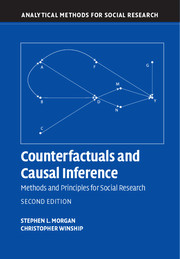Book contents
- Frontmatter
- Dedication
- Contents
- List of Figures
- List of Tables
- Acknowledgments for First Edition
- Acknowledgments for Second Edition
- I Causality and Empirical Research in the Social Sciences
- II Counterfactuals, Potential Outcomes, and Causal Graphs
- III Estimating Causal Effects by Conditioning on Observed Variables to Block Back-Door Paths
- 4 Models of Causal Exposure and Identification Criteria for Conditioning Estimators
- 5 Matching Estimators of Causal Effects
- 6 Regression Estimators of Causal Effects
- 7 Weighted Regression Estimators of Causal Effects
- IV Estimating Causal Effects When Back-Door Conditioning Is Ineffective
- V Estimation When Causal Effects Are Not Point-Identified by Observables
- VI Conclusions
- References
- Index
5 - Matching Estimators of Causal Effects
Published online by Cambridge University Press: 05 December 2014
- Frontmatter
- Dedication
- Contents
- List of Figures
- List of Tables
- Acknowledgments for First Edition
- Acknowledgments for Second Edition
- I Causality and Empirical Research in the Social Sciences
- II Counterfactuals, Potential Outcomes, and Causal Graphs
- III Estimating Causal Effects by Conditioning on Observed Variables to Block Back-Door Paths
- 4 Models of Causal Exposure and Identification Criteria for Conditioning Estimators
- 5 Matching Estimators of Causal Effects
- 6 Regression Estimators of Causal Effects
- 7 Weighted Regression Estimators of Causal Effects
- IV Estimating Causal Effects When Back-Door Conditioning Is Ineffective
- V Estimation When Causal Effects Are Not Point-Identified by Observables
- VI Conclusions
- References
- Index
Summary
The rise of the counterfactual model to prominence has increased the popularity of data analysis routines that are most clearly useful for estimating the effects of causes. The matching estimators that we will review and explain in this chapter are perhaps the best example of a classic technique that has reemerged in the past three decades as a promising procedure for estimating causal effects. Matching represents an intuitive method for addressing causal questions, primarily because it pushes the analyst to confront the process of causal exposure as well as the limitations of available data. Accordingly, among social scientists who adopt a counterfactual perspective, matching methods are fast becoming an indispensable technique for prosecuting causal questions, even though they usually prove to be the beginning rather than the end of causal analysis on any particular topic.
We begin with a brief discussion of the past use of matching methods. Then, we present the fundamental concepts underlying matching, including stratification of the data, weighting to achieve balance, and propensity scores. Thereafter, we discuss how matching is usually undertaken in practice, including an overview of various matching algorithms.
In the course of presentation, we will offer four hypothetical examples that demonstrate some of the essential claims of the matching literature, progressing from idealized examples of stratification and weighting to the implementation of alternative matching algorithms on simulated data for which the treatment effects of interest are known by construction.
- Type
- Chapter
- Information
- Counterfactuals and Causal InferenceMethods and Principles for Social Research, pp. 140 - 187Publisher: Cambridge University PressPrint publication year: 2014

